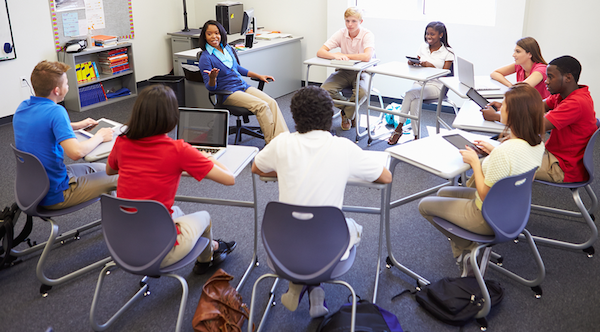Help Students Discover How the World Works
A MiddleWeb Blog
One truism that has become clearer and clearer to me is that how we teach can be as important as what we teach.
The words of Stephen Wolk, author of books including A Democratic Classroom and Caring Hearts and Critical Minds: Literature, Inquiry, and Social Responsibility, always inspire me.
He reminds us that students themselves can immeasurably shape the quality of discussion in a classroom. Wolk insists that teachers
…must help their students to understand why discussion and debate are so important to democracy and how this discourse can help us to be good people and create a better world. And perseverance pays off. Slowly, week after week, month after month, students start to talk and energetic debate begins to blossom.”
I see this unfolding of student discussion and debate every year in weekly current events presentations from my eighth-grade history students. Over the years, I’ve relaxed into the process, giving students even more agency and allowing the conversations to evolve naturally, longer and deeper.
The shape of the classroom on these days helps contribute to the collegial feel. We sit in two semicircles, one behind another, facing the board, and I usually sit in the back, trying to be unobtrusive and relaxed.
Expanding time and discussion

Now we devote all of Friday’s 43-minute period to current events. It feels as if we have all the time in the world, and the students respond in kind. And I no longer worry, as I did earlier in my career, about filling any extra time.
If there are minutes left in class at the end of the three or four weekly presentations, we’ll watch and discuss a video clip from the Wall Street Journal or New York Times, or talk about all the headlines from the articles other students have brought in for homework, or look at a chart about the latest Congressional budget or scientific study that appeared earlier that week.
If I’m stuck, I can always ask students to write how they feel about a particular article someone brought in or to look through their current events notes to discover which kinds of articles fascinate them most as a reader.
A path to understanding how students think
Some stories do engender more discussion than others. But often, even a story I think will not lead to a rich back-and-forth goes beyond what I would have imagined.

This was one of several articles on technological developments that Ella has brought in, indicative of the way many students end up focusing on a particular topic of interest throughout their four quarterly presentations.
The assignment asks students to give a brief summary of the story and then explain why they chose it, which often ends up being the most interesting part. Ella wrote:
I chose this article because I thought it was incredibly interesting how quickly the robot world is changing. I remember reading an article when I was younger about the Army using robots as spies, and now there are robots interacting more with humans. It’s odd to think that in the future, robots will be an everyday thing to see on Earth. I do not know if this is negative or positive but it is happening, and whatever impact it makes, it will be powerful.”
One question for Ella came from Miller, who asked, “When you get older, if you could get a robot, would you want to get a one?” In response, Ella said that she had discussed this story with her family over the dinner table the night before. Her parents and siblings were divided, and Ella landed on the side of concern in terms of giving robots human-like capabilities. As she exclaimed in class, “There literally could be a robot apocalypse!”
Staying in the background, usually
I often find myself much more interested in a topic after Friday’s current events presentations than I was before, because the discussion has been so whimsical or even profound. On these days, I feel that I’m teaching not just current events but also curiosity and conversation.
On occasion, I do step into the fray, especially when questions become highly politicized or when I feel students need to know facts they haven’t come across yet on their own. But most of the time I can let go and simply watch the students’ rising awareness about a social issue, or let them grapple with trying to solve a problem for which they (and sometimes the country) do not have complete information.
All I ask is that the presenters answer the questions to the best of their abilities, based on the article they read. After all, this give-and-take is how problem-solving works among adults, and the kids can always look up more information if they need it.
Moving toward a democratic classroom
My ultimate goal is that if I left the room, students could run the discussion entirely by themselves. And by the end of first quarter, it feels as if they could, I’m participating so rarely.
The students love these Friday conversations. In one of the recent online surveys I’ve given about the course, for a question asking, “Describe aspects of History 8 that have been particularly effective for you this year,” more than half mentioned daily and/or weekly current events discussions as one of their favorite aspects of the class.
Comments included “I get to be very updated on what is going around me, and it has helped me as a person,” and “Current events have given me the opportunity to truly engage with the outside world.”
Although I have fantasies of doing so, I do not by any means run an entirely democratic classroom. But bit by bit, each Friday, we come just a little closer to a classroom culture that students really own: through their ideas, through their questions, through their wondering how the world works.





































Great strategy. I’m glad these current event discussions are a regular part of your curriculum!
Mary, thank you for your enthusiasm! My classes would feel very different without them. One of these days I might try asking a different student each day to bring in a daily current event, too.
You’ve written this to encourage other teachers to make room for student-to-student discussions. It’s helpful that you remind us that it can take quite some time for students to gradually become good discussers, so don’t give up. And you acknowledge to fellow teachers it takes a concerted effort to relax and keep in the background, to let our young people’s skills develop and their discussion culture evolve with minimal interruptions by us.
Stephanie, thanks for adding your take to this conversation! Paradoxically, it does take effort to stay in the background, something I always have to remember.
Do you ask all students to read and prepare an article for class discussion or do different people have “turns” throughout the year? Also, do you have a written lesson plan to share for how you exactly do this? Do students write down their thoughts on the article, annotate article, etc so you can see they’ve actually read the article? Do you count it as homework? (I’m finding that if something doesn’t “count” students won’t do it) Do you recommend any specific sources for articles and/or discuss reliable sources prior to assigning current events? Thanks for any more insight – did you have to cut back on how much actual content you covered and how was that received?
Hi Linda, these are great questions! Every student presents once per quarter. Students write a summary of about 150 words on the article and also usually annotate it. Then they write about 50 words on why they chose the story. The current events presentations count as a really big homework grade – I agree, such grades are necessary incentives. We do discuss reliable sources, usually by looking at the NYT, WSJ, Washington Post and Los Angeles Times sites and talking about why newspaper sites are especially reliable. ProQuest Research Library and Newsela are also good sources. I do not cover quite as much historical content, but the themes we cover in current events often overlap with historical themes we have or are about to cover, which adds a richness to the historical curriculum.
Thank you for such a detailed response – I really appreciate it. I just used chapter 18 from Trevor Noah’s new book since it had the most impactful description/narrative of the importance of teaching history, critical thinking, the pain and long-term results of oppression, colonialism, about apartheid and the kicker of cultural misunderstanding on a very painful level. I am confident that it will stick with the students forever. I couldn’t explain all those in any way that would make such an impact on the students for sure! Trevor Noah read his own book on audible.com – a primary source too! Thank you again for such a helpful response! I hope to institute this!
Linda, wow, what a helpful tip about Trevor Noah’s book! The excerpt sounds very powerful.